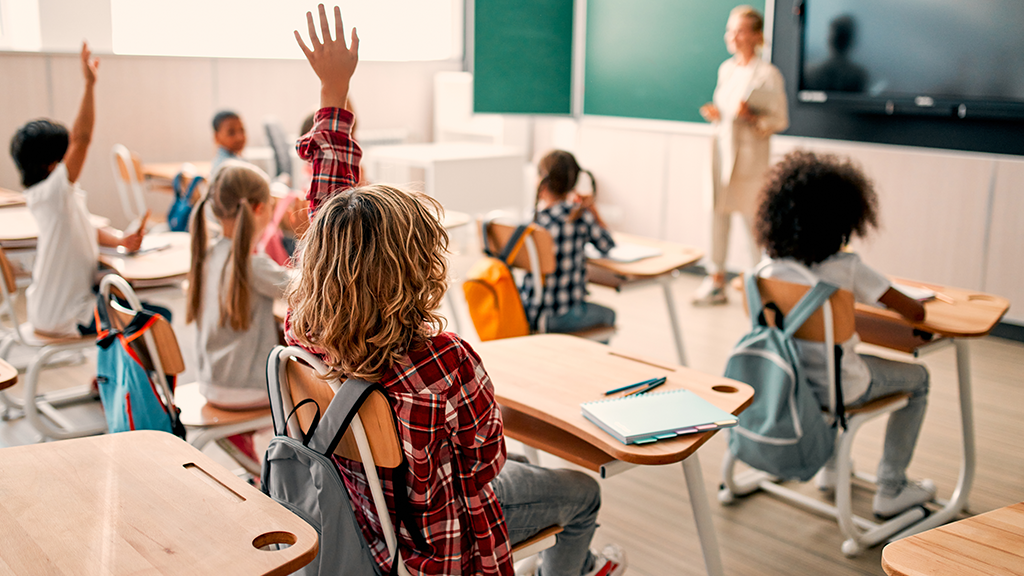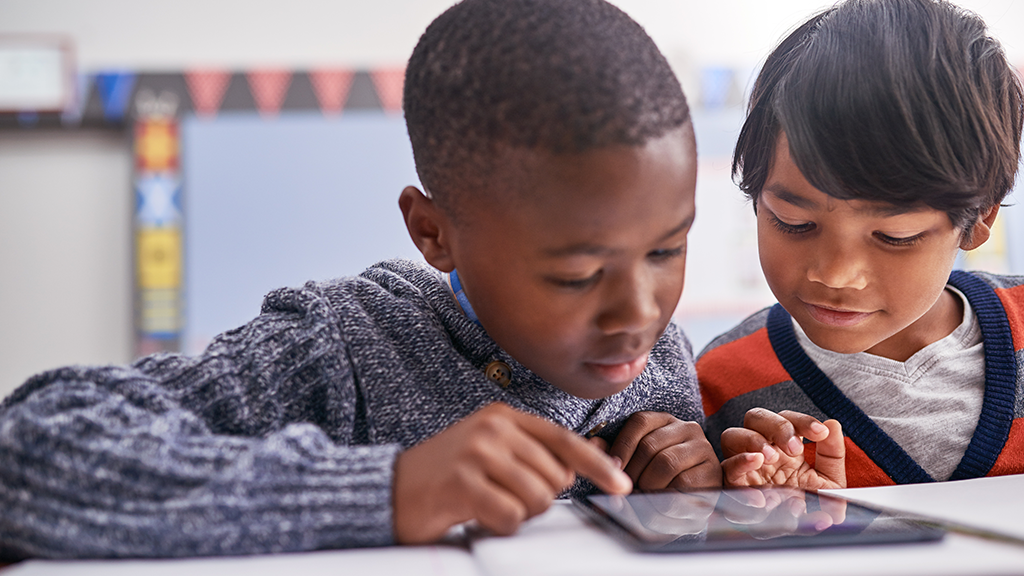
PHOTO CREDIT: VASYL/STOCK.ADOBE.COM
As school districts deal with the aftermath of the pandemic, this time of disruption gives us the opportunity to change the way students learn and achieve in the classroom learning environment. We can ultimately improve life chances for learners who have been marginalized.
Rethinking the teaching-learning process in classrooms is even more urgent given the pandemic impacts on achievement. Recently, the 2022 National Assessment of Educational Progress (NAEP) Long-Term Trend results for 9-year-olds revealed the largest average decline in reading scores since 1990, and the first score decline in mathematics since 1973. The report emphasizes that academic regression was magnified for students experiencing poverty and for Black and brown students.
Many education leaders understandably want to get back to where we were in 2019, but the opportunity and achievement gaps were still prevalent then. Instead, reimagining the teaching-learning process could be a powerful way to move forward with accelerated learning for all students.
School boards, superintendents, and district leaders can consider an overlooked but very powerful lever for academic equity: overhauling your model of instruction.
What is a model of instruction?
A model of instruction used to be defined as a framework for the way teachers plan lessons with identified instructional strategies that the teacher uses to deliver the lesson. What this definition lacked was a focus on the student’s role in the classroom learning environment, so the default model of instruction has always created a teacher-centered environment.
Teacher-centered instruction tends to result in passive and compliant students. Teachers are working too hard, and the students are not working hard enough and lack motivation to engage more robustly in their own learning. Research by Linda Darling-Hammond, among others, confirms that schools serving students from working class and working poor families and students of color are more likely to have an “increased emphasis on test-based, rote instruction.” The traditional teacher-centered model of instruction is nearly always coupled with low rigor and low student agency learning environments.
Research by Diane Friedlaender and colleagues has found that marginalized students are “more than likely to attend segregated schools with narrow and impoverished curriculum” that focuses on direct instruction in basic skills rather than the more advanced and enriched skills and knowledge that students must develop to be successful in today’s professional workforce.
The Applied Research Center within Instructional Empowerment is redefining the model of instruction to the following: a framework for the way a teacher plans lessons with identified strategies that the teacher and students use to achieve the learning target. This results in an intentional student-centered learning environment.
This is a unique definition, because models of instruction usually are defined by how the teacher is structuring and delivering the lesson, rather than by how the students are engaged in learning the lesson learning targets. In most models of instruction, even if student engagement is part of the teacher’s structure, the student’s role is controlled by the teacher.
One of the most important things to understand about a model of instruction is that it often is undefined and has unintentional effects. Most school districts do not have explicit models of instruction, which results in a “default” or legacy model prevailing. That default model is nearly always teacher centered. Most districts are operating within this default model of instruction without realizing that it is the root cause of many historical disparities for Black and brown students and students from low socioeconomic backgrounds.
Historical disparities and traditional approaches
Persistent disparities in academic achievement for Black and brown students and students from low socioeconomic backgrounds existed before the pandemic, though these gaps were exposed and exacerbated by the pandemic. Simply trying to reverse COVID learning loss and get back to pre-pandemic levels of achievement isn’t enough.

PHOTO CREDIT: PEOPLEIMAGES.COM/STOCK.ADOBE.COM
Data from the main NAEP assessments shows that the gap between the number of proficient white students versus proficient Black students has essentially held steady from 2011 to 2019. NAEP Proficient is defined as students demonstrating solid academic performance and competency over challenging subject matter. There was a 30-percentage-point gap between white and Black students for eighth-grade mathematics in 2011, and it was the same in 2019 (13 percent of Black students proficient vs. 43 percent of white students).
Many school districts implement or are increasing investments in programs such as multi-tiered systems of support (MTSS) or response to intervention (RTI) to narrow achievement gaps. But these traditional methods of remediation alone haven’t shown evidence of the level of effectiveness necessary to close the achievement gaps in 2019 and before. Such limited efforts are unlikely to reverse the magnitude of learning loss resulting from the pandemic. In fact, Rekha Balu and her colleagues found in 2015 that RTI had a more negative impact on schools than it had a positive impact.
The problem with relying on MTSS and RTI to provide the major lift in closing achievement gaps is that these programs—and others like them—are treating the symptoms instead of the root cause. They are not changing the heart of the problem: a legacy model of instruction that is perpetuating historic disparities. Programs like MTSS and RTI are beneficial in conjunction with redesigning your model of instruction, but alone they aren’t enough.
Instruction vs. instructional empowerment
The legacy model of instruction is what we are all familiar with from our own experiences in school: The teacher lectures, students listen passively, and students complete independent practice assignments such as worksheets. The student’s role is to follow instructions as the teacher directs the learning process, and as a result students become dependent and compliant learners.
A model of instructional empowerment looks much different. Students have an active role in their own learning process, collaborate with peers, and thrive as independent critical thinkers. In this type of classroom, students experience agency (the ability to self-manage themselves and their learning) as they work on challenging academic tasks, which results in productive struggle.
Productive struggle is defined as: “Students grapple with and solve a question or problem that is just beyond their current level of understanding and that requires them to examine multiple avenues of thought. Students wrestle with ideas yet persevere and come up with solutions themselves.”
Productive struggle leads to deeper engagement as students discover new understanding instead of passively receiving information from the teacher. Teachers design challenging tasks and then step back and release students to structures within the model of instructional empowerment. Students develop agency by relying on their resources and peers instead of being dependent on the teacher, and they build the capacity to access levels of academic rigor that they may never have experienced before. As students begin to believe in themselves, they invest their discretionary effort into their learning.
As students develop agency and other life skills such as decision-making, problem-solving, and effective communication, they increase their chances of succeeding beyond school and achieving upward mobility. Reforming your model of instruction is essential for academic equity. The legacy model of instruction perpetuates the status quo, while the model of instructional empowerment makes it possible to advantage students who have been historically marginalized. Students from all backgrounds benefit from a more enriched learning experience where students are actively engaged in teams and challenged to create, innovate, and debate.
Case Study: Lakewood Elementary School
Schools and districts that implement the model of instructional empowerment have experienced major gains in student achievement. For example, my research center partnered with Lakewood Elementary School in St. Petersburg, Florida, which was the lowest-performing traditional public school in the state in 2018 with an “F” grade. Lakewood serves a marginalized demographic, with 100 percent of its students receiving free and reduced meals and
15 percent homeless or in foster care.
After three years of implementing the model of instructional empowerment—from 2019 to 2021, through the pandemic and all the challenges of virtual and blended learning—Lakewood rose to an “A” grade and was among the top 6 percent of all traditional public elementary schools in the state.
While many schools experienced learning losses during the pandemic, Lakewood experienced learning gains as its students engaged in academically rigorous work and developed student agency. Instead of trying to get back to its 2019 scores, Lakewood accelerated its achievement far beyond that through the model of instructional empowerment. Lakewood outperformed its district’s average in the 2020-21 school year and increased its learning rates in math and reading during COVID. The other schools in the district, which weren’t implementing the model of instructional empowerment, experienced decreased learning rates.
Lakewood’s improvement didn’t happen overnight. It was a multiyear process, as all sustainable school improvement efforts must be. It involved an intense partnership with our research center that helped propel the school through the pandemic with a clear focus on rigor and agency in core instruction. Implementing a completely new model of instruction isn’t easy work, but it was the right work, and it changed students’ lives.
As one first-grade teacher said in a research interview, “We have kids whose older siblings never had the opportunity to take honors classes, and their parents may not have gone to college. Now, so many of our students can get on the honors track as they enter middle school because of their own efforts and results on the statewide test. It’s so amazing. So many doors are opening for our students.”
The biggest takeaway from Lakewood’s story is that school boards, superintendents, and other district leaders must ensure that their district’s model of instruction is explicitly laying out the type of pedagogy that will accelerate learning with academic rigor and student agency. Traditional teacher-centered instruction and traditional solutions like RTI and MTSS haven’t been able to get all students where they need to be. If the model of instruction is not clear, then the default will be the legacy model where students who are the most vulnerable and marginalized will not have the opportunity to thrive. When you are clear and consistent with implementing the model of instructional empowerment, you’ll put students on a path to lift themselves up.
Michael D. Toth (MichaelT@InstructionalEmpowerment.com) is founder and CEO of Instructional Empowerment (www.instructionalempowerment.com) and leads IE’s Applied Research Center.

Share this content